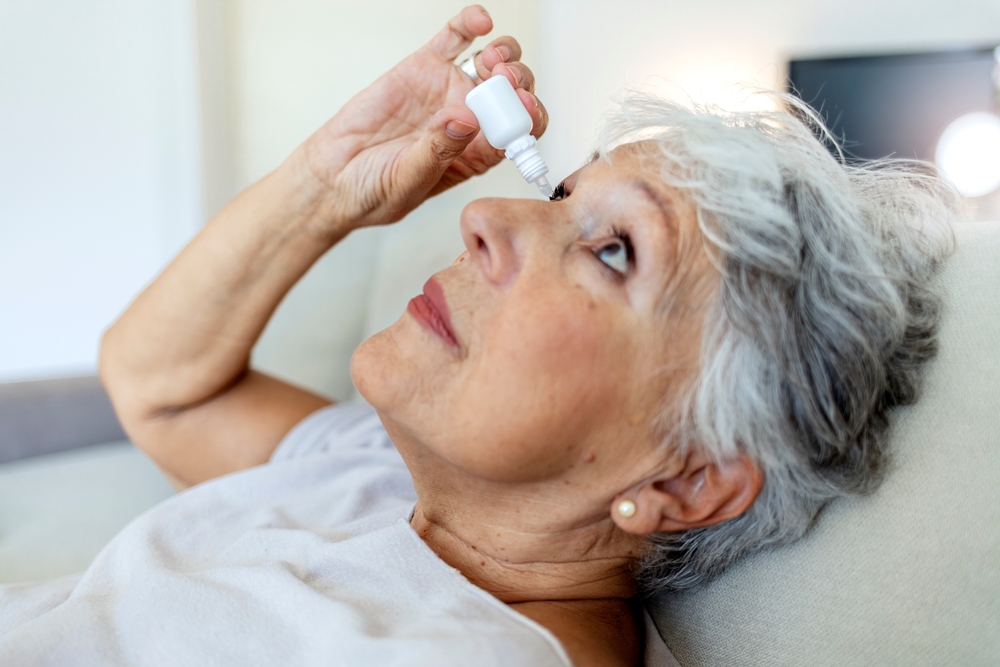Posted by: Associates in Ophthalmology (NJ) in Eye Health

Glaucoma is a serious eye condition that can lead to vision loss if left untreated. One of the most common treatments for glaucoma is the use of eye drops.
Eye drops are able to successfully lower eye pressure for many people and are often used as a first method of treatment for those diagnosed with glaucoma. Keep reading to learn more about eye drops for glaucoma treatment, including the pros and cons!
What is Glaucoma?
Glaucoma refers to a group of eye disorders that harm the optic nerve, the crucial link that sends visual signals from the eye to the brain. The most common cause of this damage is elevated pressure inside the eye, which is called intraocular pressure (IOP).
If left untreated, the persistent high pressure can lead to permanent optic nerve damage, resulting in gradual vision loss or, in severe cases, complete vision loss. Early detection and proper management of glaucoma are essential to prevent these serious consequences and maintain healthy vision.
How Do Eye Drops Help Treat Glaucoma?
Eye drops are the most common initial treatment for glaucoma. They work by either reducing the amount of fluid produced in the eye or by increasing the outflow of this fluid.
By regulating the balance of fluid in the eye, eye drops help to lower the intraocular pressure, which is crucial in preventing further damage to the optic nerve and preserving vision.
What Are the Benefits and Negatives of Glaucoma Eye Drops?
Like any treatment, glaucoma eye drops have both advantages and disadvantages. Here are a few of the pros and cons of eye drops for glaucoma:
Lower Eye Pressure and Prevent Vision Loss
The primary benefit of using glaucoma eye drops is their ability to lower intraocular pressure effectively. By reducing the pressure within the eye, these drops can help slow down or even prevent the progression of glaucoma, thus preserving vision and reducing the risk of permanent vision loss.
Must Remember to Stick to a Schedule
One of the main challenges with glaucoma eye drops is the need to use them consistently and as prescribed by your eye doctor. This often means administering the drops daily, sometimes multiple times a day.
Forgetting to use your drops or not following the prescribed schedule can reduce their effectiveness and put your vision at risk.
Can Reduce the Need for Glaucoma Surgery
In many cases, consistently using glaucoma eye drops as prescribed can help manage the condition and reduce or prevent the need for more invasive treatments, such as glaucoma surgery in some cases. By controlling intraocular pressure with drops, you may be able to avoid or delay surgical intervention.
Learning Curve
Another potential drawback of using glaucoma eye drops is the learning curve associated with administering them properly. It can take some practice to master the technique of instilling drops into your eyes, and some people may find it challenging or uncomfortable at first.
However, with patience and practice, most people become comfortable with the process.
What Other Glaucoma Treatments Are Available?
While eye drops are the most common initial treatment for glaucoma, there are other options available, particularly if drops alone are not sufficient to control intraocular pressure.
Procedures such as selective laser trabeculoplasty, often called SLT, can help improve fluid drainage and lower eye pressure. If other treatments are not effective, your eye doctor may recommend glaucoma surgery, such as trabeculectomy or glaucoma drainage implant surgery, to create a new drainage channel for fluid and reduce eye pressure.
Do you want to learn more about glaucoma treatment? Schedule an appointment at Associates in Ophthalmology in Livingston, NJ, today!

